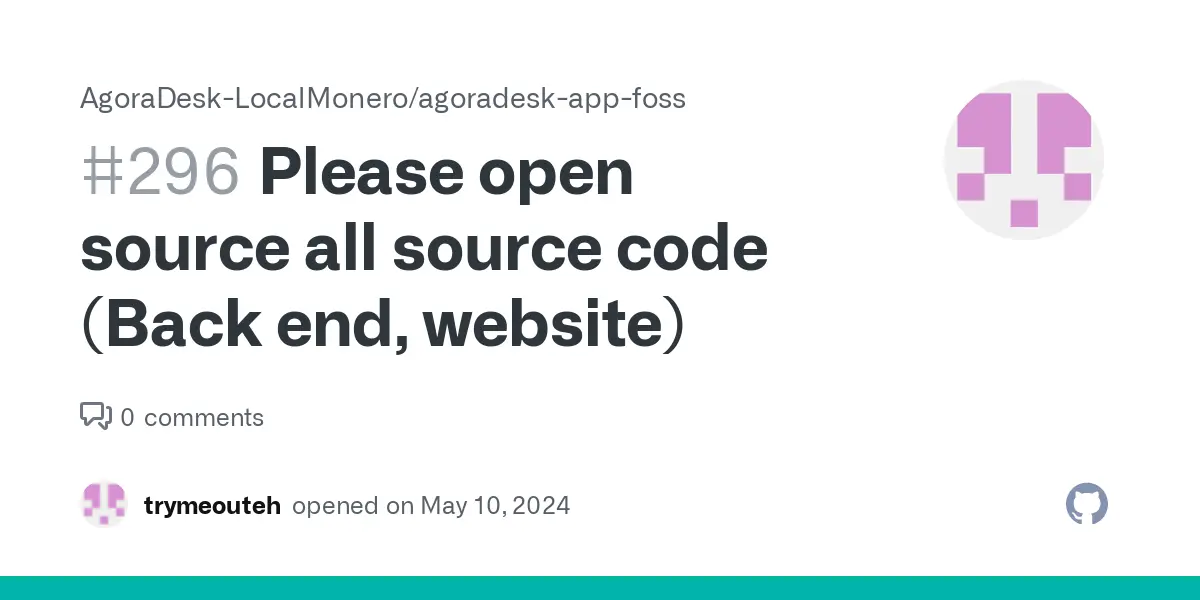If the AgoraDesk source code is released? Maybe? It can help anyone who wants to create a P2P trading platform. I think Haveno is written in Java and I have a hunch that AgoraDesk back end is not in Java.
- 65 Posts
- 51 Comments
https://github.com/AgoraDesk-LocalMonero/agoradesk-app-foss/issues/296
I hope AgoraDesk/LocalMonero will release all of their source code for their platform after they shutdown to allow anyone to fork it and start their own platform without having to build a platform and app from scratch
https://github.com/AgoraDesk-LocalMonero/agoradesk-app-foss/issues/296
Please upvote this issue if you want to see all the source code for AgoraDesk/LocalMonero be released!

 2·2 months ago
2·2 months agoWhy could a build take 5 minutes? Is it due to the size of your project or the language the bundler is written in (JavaScript being a slower option over Rust)?
The explore feature for the local instance has been made!!!
Please add the explore feature to explore the entire fediverse!

 1·3 months ago
1·3 months agoChanging
Type=oneshotand addingRemainAfterExit=yesunderneath does not allow me to boot into my system. I get this as the last terminal message[ OK ] Reached target Cloud-init target.No biggie to fix since I did this in a Virtual machine and could restore to an older snapshot.

 1·4 months ago
1·4 months agoI do use dropbear-initramfs. However the issue if I power off or the power goes out while I am unlocking the computer, I will be unable to reboot the computer using WOL. Is there something like dropbear-initramfs but instead of it being a SSH server for the LUKS lockscreen, it is a WOL enabler?

 1·4 months ago
1·4 months agoNot a bad idea as long all nodes will allow any wallet to recover all funds, not all transaction history, just balance.

 201·4 months ago
201·4 months agoPlease add the crypto addresses to the site sidebar under donations. You also may want to consider accepting BTC, BCH and LTC. Glad your accepting XMR though for private donations.

 2·4 months ago
2·4 months agoI think all cryptocurrency blockchains that function as money or store of value should do this. However I think 1 years worth is better than 10 years worth of data, or perhaps even less than a years worth of data.
As long as the blockchain size remains small enough for the adverage Joe to store the entire chain onto their mining computer for when or if Monero reaches mainstream mass adoption usage. By mainstream mass adoption I mean Monero is used as much as Visa or Mastcard is globally which I would assume will mean that Monero will need to handle 1 million transactions per second.

 2·4 months ago
2·4 months agoThe customizable post metadata is amazing! Would like to see customizeable comment metadata if possible.
Thank you devs for allowing us to customize the upvote downvote display on comments and posts!

 551·5 months ago
551·5 months agoDiscord is the worst. Requires a phone number, does not allow email aliases and logs your chats.
Matrix and SimpleX is way better

 11·5 months ago
11·5 months agoI may not have a domain name, and therefore no HTTPS, just HTTP only and can only connect by knowing the IP address and port number.

 11·5 months ago
11·5 months agoI may at times only have access to HTTP only (No HTTPS) which is one of the reasons why I want another form of encryption.
Encryption with most VPNs are more secure than HTTPS. Yes, the connection between the VPN server and the web server is not encrypted with the VPN and only HTTPS. However the encryption between the VPN and personal device is superior, not because it is relayed. My understanding is that HTTPS is “secure” for basic use, just like Windows 11 is secure. But not secure from five eye agencies unlike VPNs and other like systems like Tor and I2P.
My goal is to have a user connect to a web server and have it not possible for the web server to know what is going on, nor can anyone snooping the packets in transit know what is going on. Not know the HTML structure, form field data, etc.

 11·5 months ago
11·5 months agoMega is a good example of what I want to learn to create. Not just to transfer files, but for what text is displayed on the page and the form field values and have it so that the server admins cannot decrypt and is encrypted this data in transit.

 1·6 months ago
1·6 months agoI did find a TUI text editor that I like that is better than nano.

 1·6 months ago
1·6 months agoIsnt X being replaced with wayland? I may do that in the future once wayland is more adopted.
However I would like to achieve this on headless servers with no GUI at all.
I prefer using Rustdesk if I have to remote into a machine and see the machines GUI.

 1·6 months ago
1·6 months agoIf you are doing this as root, I have to question what it is you’re up to. The only time you should be editing files as root is config files, and then vim or nano should meet your needs.
Yes I only want to use root to edit config files. However I hate using nano and vim since they are TUI. I would like to use a GUI when editing config files.

 1·6 months ago
1·6 months agoDo you mean sftp?
I just played around with it. My file manager is Nemo (I am using Linux Mint) which allows you to connect to another computer using sftp and being able to browser the files and directories on that machine and be able to open text files.
Not the way I would prefer to do it, but a workable solution.
However I would also like to edit files on the machine with sudo privelages. I cannot connect to the machine as a normal user and right click in Nemo and open the file manager as root, as it will just open the sftp file manager as root on my device, not the remote device.
I did find this as a solution but it makes my remote machine unsecure by connecting to the remote machine as the root user by enabling the root user on the remote machine. However rather use sudo than enable the root user.
https://askubuntu.com/questions/400858/how-to-configure-sftp-to-login-in-the-directory





I think stablecoins will always have a centralized point of failure. Weather it is an algorithm, or having the coin backed by the actual asset.
I think the best stablecoins are backed by the asset 1 to 1 or a little more then 1 to 1. Most stablecoins that do this are token on smart chain contracts which have another vulnerability which is being a smart contract. Smart contracts could contain a vulnerability and if it does have a vulnerability, a new contract will need to be made and users will have to switch their old token to the new tokens. Also censorship is an issue. https://cryptonews.com/news/tether-takes-action-blacklists-validator-address-linked-25-million-mev-bot-drain-heres-what-happened.htm
And these stablecoins are not private. The only private stablecoin platform out there is Haven but Haven assets are not backed 1 to 1.
I hope there are plently of stablecoins issued on Zano in the future. Zano allows you to create an asset without creating a smart contract. All assets on Zano are private. I would like to see Tether, USDC and other issue stablecoins on Zano. Trusting the issuers on backing the stablecoin and trusting the issuer to secure their private keys to prevent hackers from inflating the asset will be the only vulnerabilities, but you will have privacy and a censorship resistant stablecoin!